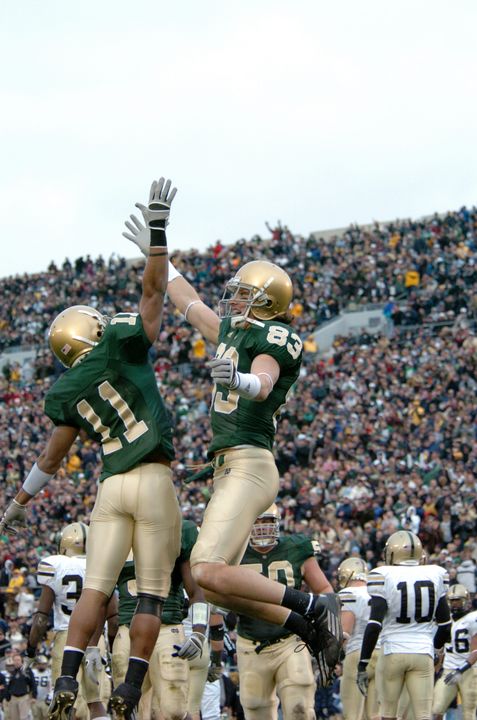Sept. 23, 2015
From the old-school green football “sweaters” with no names or numbers, to a snazzier white jersey decades later with green numbers and matching socks, to the bolder fashion statements of today that celebrate the Shamrock Series games, the “green jersey” remains an important and intriguing part of the University of Notre Dame’s history.
Some Irish coaches became forever enamored with the green look. Dan Devine went green in 42 straight games between the middle of the 1977 season and his final game coaching at Notre Dame in 1980.
And Frank Leahy also favored the green look over the traditional blue during his 11 seasons coaching at the University.
Other coaches, most notably Ara Parseghian and Lou Holtz, preferred the traditional gold and blue. Parseghian stuck with the classic look through all of his 11 years coaching at Notre Dame, and Holtz went green only twice during his 11 seasons.
Irish greats such as running back Vagas Ferguson, tight end Pete Holohan and center John Scully essentially wore nothing but a green jersey during their Notre Dame careers, while Irish All-Americans such as linebacker Tim Kelly, defensive back Mike Townsend and tight end Dave Casper never once wore green.
The history and mystique of the green jersey stretches back more than 90 years to when an Irish coach named Knute Rockne fitted his team with green uniforms – not for any motivational ploy or fashion statement – but to simply distinguish his players from opponents that shared the same team colors.
Barring any fashion surprises, the 2015 Shamrock Series Game at Fenway Park this November will be the lone “Green Jersey Game” for the Irish this season, and the fifth of Brian Kelly’s coaching career at Notre Dame.
So from Rockne to Kelly, let’s take a look at the long and evolving history of Notre Dame “Wearing o’ the Green.”
The Genesis of Green
While the basic school colors haven’t radically changed during the proud UND history, the shades and styles are many.
Yellow and blue – yellow symbolizing light and blue truth – became the official school colors about the same time Notre Dame was founded in 1842.
But sometime shortly after the famous Golden Dome was gilded and then crowned with the statue of “Our Mother” Mary in 1886, gold and blue were adopted as the new school colors and the football team was outfitted in standard-issue blue football “sweaters.”
It took about 30 years for green to make the uniform scene when Rockne outfitted his varsity in blue and his freshmen players (ineligible during that era) in green.
And while accounts vary among Notre Dame historians as to the first time green shirts were used in a game, many accounts suggest it was in 1921 when Rockne and his team traveled to Iowa City to play the Iowa Hawkeyes.
Iowa, which finished that season undefeated, handed Notre Dame its only loss of the year in a tough 10-7 tussle, but a tradition was born.
Rockne theorized that the green jerseys would help his passers better locate their receivers so a wardrobe change became routine when playing teams of similar color schemes. Navy provides the best example.
In 1927, during Notre Dame’s first-ever matchup against the mighty Navy Midshipmen, the green jerseys were used for both player distinction and also for the first time as a motivational tactic.
Rockne started his second-stringers in that game, and only five minutes in, Notre Dame already trailed Navy, 6-0. Down but not out, Rockne had his powerful starting lineup make a grand and green entrance onto the field.
Sportswriter George Trevor of the New York Sun described the moment and Notre Dame’s 19-6 comeback win this way.
“Instantaneously the Notre Dame regulars yanked off their blue outer sweaters and like a horde of green Gila monsters darted onto the field. From that moment on, Notre Dame held the initiative, imposed its collective will upon Navy.”
Rockne and the Irish pulled the same green fashion move the following season against Navy in a 7-0 Notre Dame win at Soldier Field in Chicago.
Here is how the game was detailed in the 1928 edition of Scholastic Football Review.
“Mr. K.K. Rockne may, or may not, be a psychologist. But, he did array his Fighting Irish in bright green jerseys for their battle with the United States Naval Academy. Mr. Rockne evidently surmised that garbing a band of native and adopted Irish in their native color is somewhat akin to showing a bull the Russian flag.”
For the remainder of Rockne’s 13-year coaching career that ended in 1930, and through the coaching tenures of his predecessors Hunk Anderson and Elmer Layden, green jerseys were only occasionally donned.
They first became a mainstay during the Golden Era of Irish football under the legendary Coach Leahy.
Perhaps because of his Irish heritage, Leahy frequently outfitted his players in green uniforms, sometimes for an entire season. Many pictures of Irish stars dressed in green showcase the Leahy era.
There’s the Angelo Bertelli’s 1943 Heisman Trophy painting, Heisman winner Johnny Lujack on the cover of Life magazine in September of 1947, and another Notre Dame Heisman winner, Johnny Lattner, dressed in green on the covers of Sport and Time magazines in 1953, just to name a few.
The tradition of using green almost exclusively continued for most of 16 seasons during Leahy’s 11 years, and again through Terry Brennan’s five seasons, before new head coach Joe Kuharich returned the uniform color back to the traditional blue in 1959.
Blue was the rule, but Kuharich occasionally revived the custom of wearing green during his four difficult seasons here.
Following Kuharich, one-year interim head coach Hugh Devore tried to go out in style in 1963, dressing his players in green jerseys for the season finale at Yankee Stadium against Syracuse. But a 14-7 loss marked the end of the short Devore coaching stint, the start of the Ara era and the last sighting of the green jerseys for the next 13 full seasons.
“I wanted to get one consistent look for a football team,” Parseghian explained, saying he became “confused” by the purpose of the green look during previous coaching regimes.
The lack of an appearance for more than a decade relegated the green jersey all but forgotten, only helping to set up the greatest moment and memory upon its triumphant return.
Devine Intervention
Devine took over for Parseghian before the 1975 season and kept the standard blue Irish uniform status quo, until Oct. 22, 1977, that is.
Playing at home against arch-rival USC, the Notre Dame players performed pre-game warm-ups in their traditional blue jerseys before heading back to the locker room. Surprised and thrilled, the players found a different game jersey hanging in their lockers. To the enthusiastic delight of the Notre Dame fans and players, the Irish stormed from their tunnel wearing green for the first time in 144 games.
Now known as the “Trojan Horse” and the “Green Jersey” game, Notre Dame won 49-19 and made USC green with envy by parlaying the 30-point win that day into a national championship about 10 weeks later.
Title-winning quarterback Joe Montana called this game one of his greatest memories at Notre Dame.
“Everyone was screaming and yelling in the locker room,” Montana recalled. “Sometimes it takes a little spark to get you going, and that’s what it was. It was something to get us a little more hyped for something we really didn’t need to be more hyped for. It worked out well.”
It worked out so well for Devine, the coach suited his team in green for nearly every game during the final three-and-a-half seasons he was the Notre Dame coach.
Adding to the “green mystique,” Devine mixed in some variances to the uniforms in the late 1970s, most notably a white jersey with green numbers – wore in both a 38-10 win over Texas in the 1978 Cotton Bowl that clinched the 1977 national title, and the “Chicken Soup” game in the 1979 Cotton Bowl when the Irish outscored Houston 23-0 in the fourth quarter to secure a 35-34 win.
Devine finished 32-9-1 in the 42 games he suited his team in green.
Gerry Faust took over for Devine in 1981 and used green jerseys twice in his five seasons as head coach, most notably in a 27-6 win over USC in 1983, six years to the day after Devine’s “Green Jersey” triumph over the Trojans. The Irish also wore green in the second half only of a 37-3 win over USC in 1985, Faust’s last season at Notre Dame.
Holtz And History
Looking for better on-field results when he took over for Faust in 1986 – and emphasizing function and not fashion – new head coach Lou Holtz relied exclusively on the traditional blue jerseys during his first six full regular seasons at Notre Dame.
By his own admission, Holtz was more interested in adding an interlocking “ND” to the Notre Dame helmet than he was redefining school colors.
“The helmets represent the Golden Dome,” University president Rev. Theodore Hesburgh conveyed to Holtz.
“Well, how about if we paint the Dome?” replied the eternally witty Irish coach.
Holtz needed six seasons to finally buck his blue uniform routine against Florida in the 1992 Sugar Bowl, dressing his team in white road jerseys with green numbers and socks, exactly 11 years to the day after Notre Dame last donned this same look against Georgia in the 1981 Sugar Bowl. Holtz’s Irish beat the Gators 39-28.
Three years later, Holtz again outfitted his team in green for the 1995 Fiesta Bowl against Colorado – a 41-24 Irish loss – in the second and final time in 11 seasons that Holtz strayed from the standard blue look.
Holtz successor, Bob Davie, used green jerseys only once during his five seasons as head coach – a 35-28 loss to Georgia Tech in the 1999 Gator Bowl.
The green jerseys were again put on moth balls after that game until November of 2002 when rookie coach Tyrone Willingham, fresh of a road upset of Florida State, and very much in national talk as the No. 4 team in the country, dusted them off for a home game against rival Boston College.
The ploy didn’t work as the Eagles pulled a stunning 14-7 upset to spoil Notre Dame’s magical season. Following the green game, Willingham went just 13-15 during the rest of his time as Irish coach.
As a Notre Dame student and attendee of Devine’s epic “Green Jersey” revival game, Charlie Weis was understandably intrigued by the mystique and history of the celebrated green jersey when he took the Irish coaching job in 2005.
Weis had his players wear green for one game in each of his first three seasons – the most memorable being when he surprised Irish fans before the infamous “Bush Push” game in 2005, a heartbreaking 34-31 last-second loss to top-ranked USC.
Notre Dame wore the same green uniforms the following season in a 41-9 thrashing of Army on Senior Day, ending a streak of four straight losses over 15 years since the Irish had last won a game wearing a green jersey.
Fitted in 2007 with a retro replica of the 1977 “Trojan Horse” uniform, Notre Dame was beaten 38-0 by USC in one of the most lopsided defeats in both Notre Dame Stadium and green jersey history.
As for Kelly, he has pulled no surprising or motivational green jersey tactics during his five-plus seasons on the job.
Three of Kelly’s four career green jersey games have come as part of the popular Shamrock Series – victories over Army in 2010, Maryland in 2011 and Arizona State in 2013 – while his lone loss in green, a tough 35-31 defeat at Michigan, was part of a throwback night to help celebrate the first-ever game played under the lights at Michigan Stadium.
Notre Dame will forever be known for its Gold and Blue, but that will never keep the program from occasionally making other schools green with envy.
*************************************
Dating back more than 90 years, Notre Dame has used the green jersey as a sporadic program staple – and often a surprising statement – to celebrate and motivate its football team and fans.
Former head coach Dan Devine (1975-80) went 32-9-1 with his team wearing green from when he revived the green jersey from a 13-season hibernation in the legendary “Trojan Horse” triumph of USC in 1977.
Following is a graphical look at the 13 green jersey games since Devine retired as Notre Dame’s coach. The following four coaches combine for a 7-6 record in green.
Gerry Faust (2-0)
1983 vs. USC
–Irish won 27-6
1985 vs. USC:
-Irish won 37-3
Lou Holtz (1-1)
1992 Sugar Bowl vs. Florida, New Orleans
-Irish won 39-28 in white jerseys with green numbers
1995 Fiesta Bowl vs. Colorado, Tempe, Arizona
-Irish lost 41-24
Bob Davie (0-1)
1999 Gator Bowl vs. Georgia Tech, Jacksonville, Florida
-Irish lost 35-28
Tyrone Willingham (0-1)
2002 vs. Boston College
-Irish lost 14-7
Charlie Weis (1-2)
2005 vs. USC
-Irish lost 34-31
2006 vs. Army
-Irish won 41-9
2007 vs. USC
-Irish lost 38-0
Brian Kelly (3-1)
2010 vs. Army at Yankee Stadium, New York City
-Irish won 27-3*
2011 @ Michigan, Ann Arbor
-Irish lost 35-31 with white jerseys, green numbers and socks
2011 Maryland at FedEx Field, Landover, Maryland
-Irish won 45-21*
2013 Arizona State at AT&T Stadium, Arlington Texas
-Irish won 37-34* with white jerseys, green numbers and socks
2015 Boston College at Fenway Park, Boston (Nov. 21)*
*-Annual Shamrock Series Game
Many thanks to IrishIllustrated.com editor Tim Prister and Notre Dame senior associate athletic director John Heisler for research assistance through their book, “Always Fighting Irish: Players, Coaches, and Fans Share Their Passion for Notre Dame Football.”
– By Todd Burlage








